-
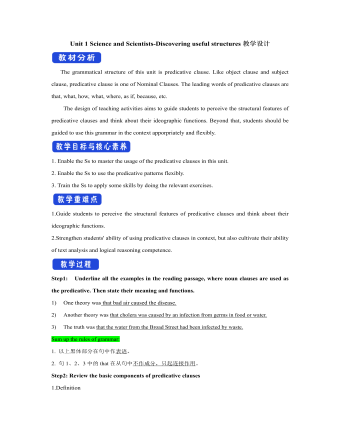
新人教版高中英语选修2Unit 1 Science and Scientists-Discovering useful structures教学设计
The grammatical structure of this unit is predicative clause. Like object clause and subject clause, predicative clause is one of Nominal Clauses. The leading words of predicative clauses are that, what, how, what, where, as if, because, etc.The design of teaching activities aims to guide students to perceive the structural features of predicative clauses and think about their ideographic functions. Beyond that, students should be guided to use this grammar in the context apporpriately and flexibly.1. Enable the Ss to master the usage of the predicative clauses in this unit.2. Enable the Ss to use the predicative patterns flexibly.3. Train the Ss to apply some skills by doing the relevant exercises.1.Guide students to perceive the structural features of predicative clauses and think about their ideographic functions.2.Strengthen students' ability of using predicative clauses in context, but also cultivate their ability of text analysis and logical reasoning competence.Step1: Underline all the examples in the reading passage, where noun clauses are used as the predicative. Then state their meaning and functions.1) One theory was that bad air caused the disease.2) Another theory was that cholera was caused by an infection from germs in food or water.3) The truth was that the water from the Broad Street had been infected by waste.Sum up the rules of grammar:1. 以上黑体部分在句中作表语。2. 句1、2、3中的that在从句中不作成分,只起连接作用。 Step2: Review the basic components of predicative clauses1.Definition
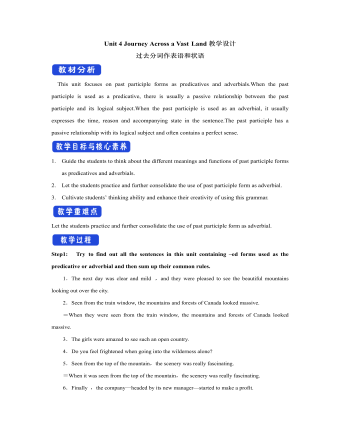
新人教版高中英语选修2Unit 4 Journey Across a Vast Land教学设计
当孩子们由父母陪同时,他们才被允许进入这个运动场。3.过去分词(短语)作状语时的几种特殊情况(1)过去分词(短语)在句中作时间、条件、原因、让步状语时,相当于对应的时间、条件、原因及让步状语从句。Seen from the top of the mountain (=When it is seen from the top of the mountain), the whole town looks more beautiful.从山顶上看,整个城市看起来更美了。Given ten more minutes (=If we are given ten more minutes), we will finish the work perfectly.如果多给十分钟,我们会完美地完成这项工作。Greatly touched by his words (=Because she was greatly touched by his words), she was full of tears.由于被他的话深深地感动,她满眼泪花。Warned of the storm (=Though they were warned of the storm), the farmers were still working on the farm.尽管被警告了风暴的到来,但农民们仍在农场干活。(2)过去分词(短语)在句中作伴随、方式等状语时,可改为句子的并列谓语或改为并列分句。The teacher came into the room, followed by two students (=and was followed by two students).后面跟着两个学生,老师走进了房间。He spent the whole afternoon, accompanied by his mom(=and was accompanied by his mom).他由母亲陪着度过了一整个下午。
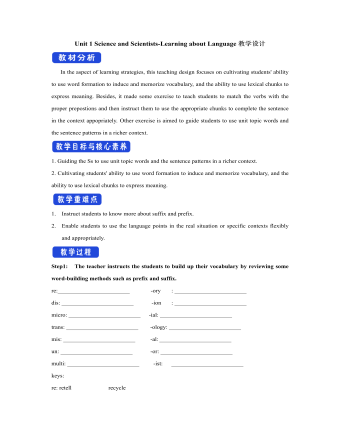
新人教版高中英语选修2Unit 1 Science and Scientists-Learning about Language教学设计
Step 7: complete the discourse according to the grammar rules.Cholera used to be one of the most 1.__________ (fear) diseases in the world. In the early 19th century, _2_________ an outbreak of cholera hit Europe, millions of people died. But neither its cause, 3__________ its cure was understood. A British doctor, John Snow, wanted to solve the problem and he knew that cholera would not be controlled _4_________ its cause was found. In general, there were two contradictory theories 5 __________ explained how cholera spread. The first suggested that bad air caused the disease. The second was that cholera was caused by an _6_________(infect) from germs in food or water. John Snow thought that the second theory was correct but he needed proof. So when another outbreak of cholera hit London in 1854, he began to investigate. Later, with all the evidence he _7_________ (gather), John Snow was able to announce that the pump water carried cholera germs. Therefore, he had the handle of the pump _8_________ (remove) so that it couldn't be used. Through his intervention,the disease was stopped in its tracks. What is more, John Snow found that some companies sold water from the River Thames that __9__________________ (pollute) by raw waste. The people who drank this water were much more likely _10_________ (get) cholera than those who drank pure or boiled water. Through John Snow's efforts, the _11_________ (threaten) of cholera around the world saw a substantial increase. Keys: 1.feared 2.when 3. nor 4.unless 5.that/which 6.infection 7.had gathered 8.removed 9.was polluted 10.to get 11. threat
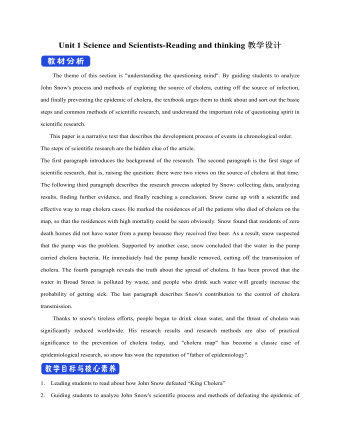
新人教版高中英语选修2Unit 1 Science and Scientists-Reading and thinking教学设计
Step 5: After learning the text, discuss with your peers about the following questions:1.John Snow believed Idea 2 was right. How did he finally prove it?2. Do you think John Snow would have solved this problem without the map?3. Cholera is a 19th century disease. What disease do you think is similar to cholera today?SARS and Covid-19 because they are both deadly and fatally infectious, have an unknown cause and need serious public health care to solve them urgently.keys:1. John Snow finally proved his idea because he found an outbreak that was clearly related to cholera, collected information and was able to tie cases outside the area to the polluted water.2. No. The map helped John Snow organize his ideas. He was able to identify those households that had had many deaths and check their water-drinking habits. He identified those houses that had had no deaths and surveyed their drinking habits. The evidence clearly pointed to the polluted water being the cause.3. SARS and Covid-19 because they are both deadly and fatally infectious, have an unknown cause and need serious public health care to solve them urgently.Step 6: Consolidate what you have learned by filling in the blanks:John Snow was a well-known _1___ in London in the _2__ century. He wanted to find the _3_____ of cholera in order to help people ___4_____ it. In 1854 when a cholera __5__ London, he began to gather information. He ___6__ on a map ___7___ all the dead people had lived and he found that many people who had ___8____ (drink) the dirty water from the __9____ died. So he decided that the polluted water ___10____ cholera. He suggested that the ___11__ of all water supplies should be _12______ and new methods of dealing with ____13___ water be found. Finally, “King Cholera” was __14_____.Keys: 1. doctor 2. 19th 3.cause 4.infected with 5.hit 6.marked 7.where 8.drunk 9.pump 10.carried 11.source 12.examined 13.polluted 14.defeatedHomework: Retell the text after class and preview its language points
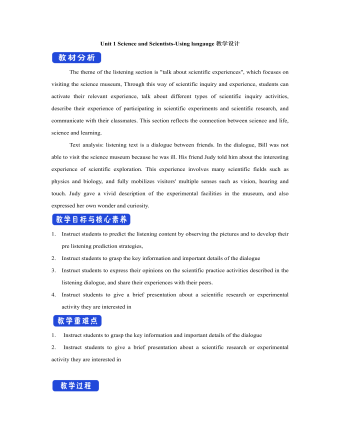
新人教版高中英语选修2Unit 1 Science and Scientists-Using langauge教学设计
This happens because the dish soap molecules have a strong negative charge, and the milk molecules have a strong positive charge. Like magnets, these molecules are attracted to each other, and so they appear to move around on the plate, taking the food coloring with them, making it look like the colors are quickly moving to escape from the soap.Listening text:? Judy: Oh, I'm so sorry that you were ill and couldn't come with us on our field trip. How are you feeling now? Better?? Bill: Much better, thanks. But how was it?? Judy: Wonderful! I especially liked an area of the museum called Light Games.it was really cool. They had a hall of mirrors where I could see myself reflected thousands of times!? Bill: A hall of mirrors can be a lot of fun. What else did they have?? Judy: Well, they had an experiment where we looked at a blue screen for a while, and then suddenly we could see tiny bright lights moving around on it. You'll never guess what those bright lights were!? Bill: Come on, tell me!? Judy: They were our own blood cells. For some reason, our eyes play tricks on us when we look at a blue screen, and we can see our own blood cells moving around like little lights! But there was another thing I liked better. I stood in front of a white light, and it cast different shadows of me in every color of the rainbow!? Bill: Oh, I wish I had been there. Tell me more!? Judy: Well, they had another area for sound. They had a giant piano keyboard that you could use your feet to play. But then, instead of playing the sounds of a piano, it played the voices of classical singers! Then they had a giant dish, and when you spoke into it, it reflected the sound back and made it louder. You could use it to speak in a whisper to someone 17 meters away.? Bill: It all sounds so cool. I wish I could have gone with you? Judy: I know, but we can go together this weekend. I'd love to go there again!? Bill: That sounds like a great idea!
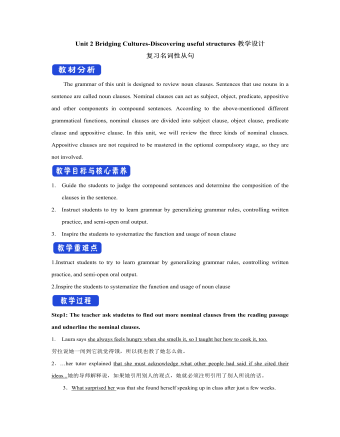
新人教版高中英语选修2Unit 2 Bridging Cultures-Discovering useful structures教学设计
The grammar of this unit is designed to review noun clauses. Sentences that use nouns in a sentence are called noun clauses. Nominal clauses can act as subject, object, predicate, appositive and other components in compound sentences. According to the above-mentioned different grammatical functions, nominal clauses are divided into subject clause, object clause, predicate clause and appositive clause. In this unit, we will review the three kinds of nominal clauses. Appositive clauses are not required to be mastered in the optional compulsory stage, so they are not involved.1. Guide the students to judge the compound sentences and determine the composition of the clauses in the sentence.2. Instruct students to try to learn grammar by generalizing grammar rules, controlling written practice, and semi-open oral output.3. Inspire the students to systematize the function and usage of noun clause1.Instruct students to try to learn grammar by generalizing grammar rules, controlling written practice, and semi-open oral output.2.Inspire the students to systematize the function and usage of noun clauseStep1: The teacher ask studetns to find out more nominal clauses from the reading passage and udnerline the nominal clauses.
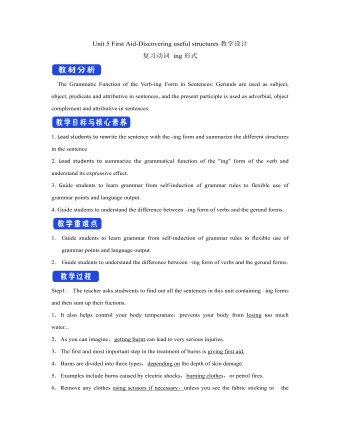
新人教版高中英语选修2Unit 5 First Aid-Discovering useful structures教学设计
You have no excuse for not going.你没有理由不去。He was punished for not having finished his homework.他因未完成作业而受到惩罚。2.动词ing形式复合结构由物主代词或人称代词宾格、名词所有格或普通格加动词ing,即“sb./sb.'s+doing”构成。动词ing形式的复合结构实际上是给动词ing形式加了一个逻辑主语。动词ing形式的复合结构有四种形式:①形容词性物主代词+动词ing②名词所有格+动词ing③代词宾格+动词ing④名词+动词ingHer coming to help encouraged all of us.她来帮忙鼓舞了我们所有人。The baby was made awake by the door suddenly shutting.这个婴儿被突然的关门声吵醒了。Can you imagine him/Jack cooking at home?你能想象他/杰克在家做饭的样子吗?无生命名词无论是作主语还是作宾语都不能用第②种形式。Tom's winning first prize last year impressed me a lot.汤姆去年得了一等奖使我印象深刻。Do you mind my/me/Jack's/Jack leaving now?你介意我/杰克现在离开吗?Excuse me for my not coming on time.很抱歉我没能按时来。His father's being ill made him worried.他父亲病了,他很担心。We are looking forward to the singer's/the singer to give us a concert.我们盼望着这位歌手来给我们举办一场演唱会。
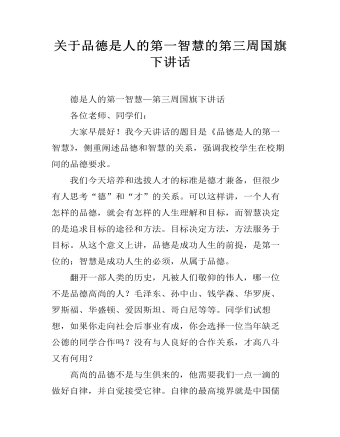
关于品德是人的第一智慧的第三周国旗下讲话
德是人的第一智慧—第三周国旗下讲话各位老师、同学们:大家早晨好!我今天讲话的题目是《品德是人的第一智慧》,侧重阐述品德和智慧的关系,强调我校学生在校期间的品德要求。我们今天培养和选拔人才的标准是德才兼备,但很少有人思考“德”和“才”的关系。可以这样讲,一个人有怎样的品德,就会有怎样的人生理解和目标,而智慧决定的是追求目标的途径和方法。目标决定方法,方法服务于目标。从这个意义上讲,品德是成功人生的前提,是第一位的;智慧是成功人生的必须,从属于品德。翻开一部人类的历史,凡被人们敬仰的伟人,哪一位不是品德高尚的人?毛泽东、孙中山、钱学森、华罗庚、罗斯福、华盛顿、爱因斯坦、哥白尼等等。同学们试想想,如果你走向社会后事业有成,你会选择一位当年缺乏公德的同学合作吗?没有与人良好的合作关系,才高八斗又有何用?高尚的品德不是与生俱来的,他需要我们一点一滴的做好自律,并自觉接受它律。自律的最高境界就是中国儒家文化强调的“慎独”,即一个人独处时也能保持同样的高尚品德境界,而不是没人看见就随手扔垃圾,随性破坏公物或干点什么见不得人的坏事。

人教版高中数学选修3分类加法计数原理与分步乘法计数原理(2)教学设计
当A,C颜色相同时,先染P有4种方法,再染A,C有3种方法,然后染B有2种方法,最后染D也有2种方法.根据分步乘法计数原理知,共有4×3×2×2=48(种)方法;当A,C颜色不相同时,先染P有4种方法,再染A有3种方法,然后染C有2种方法,最后染B,D都有1种方法.根据分步乘法计数原理知,共有4×3×2×1×1=24(种)方法.综上,共有48+24=72(种)方法.故选B.答案:B5.某艺术小组有9人,每人至少会钢琴和小号中的一种乐器,其中7人会钢琴,3人会小号,从中选出会钢琴与会小号的各1人,有多少种不同的选法?解:由题意可知,在艺术小组9人中,有且仅有1人既会钢琴又会小号(把该人记为甲),只会钢琴的有6人,只会小号的有2人.把从中选出会钢琴与会小号各1人的方法分为两类.第1类,甲入选,另1人只需从其他8人中任选1人,故这类选法共8种;第2类,甲不入选,则会钢琴的只能从6个只会钢琴的人中选出,有6种不同的选法,会小号的也只能从只会小号的2人中选出,有2种不同的选法,所以这类选法共有6×2=12(种).因此共有8+12=20(种)不同的选法.

人教版高中数学选修3分类加法计数原理与分步乘法计数原理(1)教学设计
问题1. 用一个大写的英文字母或一个阿拉伯数字给教室里的一个座位编号,总共能编出多少种不同的号码?因为英文字母共有26个,阿拉伯数字共有10个,所以总共可以编出26+10=36种不同的号码.问题2.你能说说这个问题的特征吗?上述计数过程的基本环节是:(1)确定分类标准,根据问题条件分为字母号码和数字号码两类;(2)分别计算各类号码的个数;(3)各类号码的个数相加,得出所有号码的个数.你能举出一些生活中类似的例子吗?一般地,有如下分类加法计数原理:完成一件事,有两类办法. 在第1类办法中有m种不同的方法,在第2类方法中有n种不同的方法,则完成这件事共有:N= m+n种不同的方法.二、典例解析例1.在填写高考志愿时,一名高中毕业生了解到,A,B两所大学各有一些自己感兴趣的强项专业,如表,
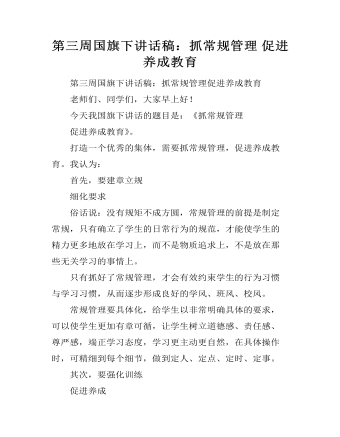
第三周国旗下讲话稿:抓常规管理 促进养成教育
第三周国旗下讲话稿:抓常规管理促进养成教育老师们、同学们,大家早上好!今天我国旗下讲话的题目是:《抓常规管理促进养成教育》。打造一个优秀的集体,需要抓常规管理,促进养成教育。我认为:首先,要建章立规细化要求俗话说:没有规矩不成方圆,常规管理的前提是制定常规,只有确立了学生的日常行为的规范,才能使学生的精力更多地放在学习上,而不是物质追求上,不是放在那些无关学习的事情上。只有抓好了常规管理,才会有效约束学生的行为习惯与学习习惯,从而逐步形成良好的学风、班风、校风。常规管理要具体化,给学生以非常明确具体的要求,可以使学生更加有章可循,让学生树立道德感、责任感、尊严感,端正学习态度,学习更主动更自然,在具体操作时,可精细到每个细节,做到定人、定点、定时、定事。其次,要强化训练促进养成学生是日常管理的对象,更是常规管理的主体,为此,我们以班级教育、自我教育、传授教育为主渠道,训练学生自我约束,自我管理的能力
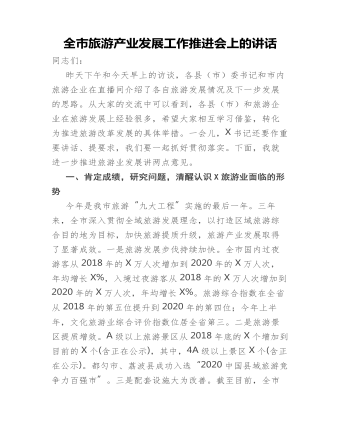
全市旅游产业发展工作推进会上的讲话
在看到成绩的同时,我们也要清醒地认识到存在的问题和不足。一是全市旅游景区业态单一,产品同质化严重、特色化挖掘不够以及运营能力不强等问题突出。比如,瓮安古邑旅游区、惠水好花红旅游区如何发挥良好效益,还需要深入研究推动。二是全市旅游业仍以观光旅游产品为主,产业链条不长,休闲度假温泉、度假酒店、旅居村寨等康养、体验产品较少,供给不足,“+旅游”这篇大文章做得不够,统筹还不到位。三是全市大多数景区仍以政府主导为主,不善于谋划和经营,产出账算的还不够,造成了一些烂尾项目、僵尸项目。四是旅游营销不够精准高效,大多还停留在传统营销推介模式,利用新媒体宣传营销还有差距,客源地、目标市场定位还不够精准,特别是在细分目标市场和客群市场上做得还不够。
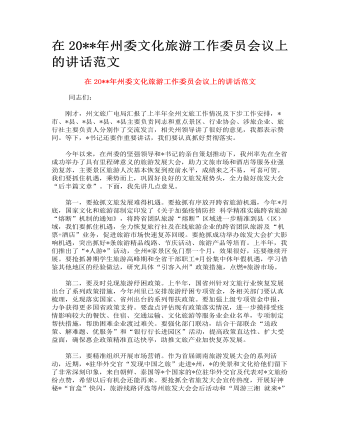
在州委文化旅游工作委员会议上的讲话范文
第一,要抢抓文旅发展难得机遇。要抢抓有序放开跨省旅游机遇,今年*月底,国家文化和旅游部制定印发了《关于加强疫情防控科学精准实施跨省旅游“熔断”机制的通知》,将跨省团队旅游“熔断”区域进一步精准到县(区)域,我们要抓住机遇,全力恢复旅行社及在线旅游企业的跨省团队旅游及“机票+酒店”业务,促进旅游市场快速复苏回暖。要抢抓成功举办旅发大会扩大影响机遇,突出抓好*条旅游精品线路、节庆活动、旅游产品等培育。上半年,我们推出了“*人游*”活动,全州*家景区免门票一个月,效果很好,还要继续开展。要抢抓暑期学生旅游高峰期和全省干部职工*月份集中休年假机遇,学习借鉴其他地区的经验做法,研究具体“引客入州”政策措施,点燃*旅游市场。 第二,要及时兑现旅游纾困政策。上半年,国省州针对文旅行业恢复发展出台了系列政策措施,今年州里已安排旅游纾困专项资金,各相关部门要认真梳理,兑现落实国家、省州出台的系列帮扶政策。要加强上级专项资金申报,力争获得更多国省政策支持。要盘点评估现有政策落实情况,进一步摸排受疫情影响较大的餐饮、住宿、交通运输、文化旅游等服务业企业名单,专项制定帮扶措施,帮助困难企业渡过难关。要强化部门联动,结合干部联企“送政策、解难题、优服务”和“银行行长进园区”活动,提高政策直达性、扩大受益面,确保惠企政策精准直达快享,助推文旅产业加快复苏发展。 第三,要精准组织开展市场营销。作为首届湖南旅游发展大会的系列活动,近期,*驻华外交官“发现中国之旅”走进*州,*的美景和文化给他们留下了非常深刻印象,来自朝鲜、泰国等*个国家的*位驻华外交官及代表对*文旅纷纷点赞,希望以后有机会还能再来。要抢抓全省旅发大会宣传热度,开展好神秘*“盲盒”快闪,旅游线路评选等州旅发大会会后活动和“周游三湘 就来*”推广活动。要组织客源市场营销“小分队”,在长沙、广州等重点客源城市开展精准营销,与重庆、湖北、广东等地洽谈合作细节。鼓励各县市区围绕旅发大会、暑期旅游市场策划各类营销活动,办好湖南省夏季乡村旅游节、*旅拍节第节庆活动,营造浓厚宣传营销氛围。要树立全州“一盘棋”思想,强化整体形象包装,建立健全全州旅游宣传互推、智慧旅游、旅游通达、零客互推、利益共享等保障机制,改变过去各县市区文旅宣传互推“各自为政”力量分散的现状,加快构建旅游联动发展大格局。同时,要加大文化旅游资源整合,加快组建州级文化旅游投资集团公司,加大文旅龙头企业引进和培育力度,支持文旅企业参与市场竞争、不断做大做强。

xx区2023年国庆节假日文化旅游工作总结
一、从严做好疫情防控工作节前,区委常委、区政府副区长xx,区委常委、宣传部长xx,区政府副区长xx分别带队检查文旅场所疫情防控和节日安全工作,区文化旅游委召开国庆节前安全生产疫情防控暨廉政教育工作会,发布2023年国庆期间及前后疫情防控措施。节假日期间,xx副区长主持召开国庆期间文化旅游行业疫情防控调度会,要求从严从紧抓好文化和旅游行业疫情防控工作。按照市文化旅游委《关于扎实做好2023年国庆节期间文化和旅游假日市场相关工作的通知》要求,督导A级景区严格落实“限量、预约、错峰”要求,对所有入园游客进行扫码测温,查验72小时核酸检测阴性证明,符合属地疫情防控要求的方可进入;督导星级饭店加强通风消毒,对入住人员查验健康码,查验72小时内核酸检测阴性证明;督导辖区旅行社和在线旅游企业严格落实跨省旅游经营活动“熔断”机制;督导文化经营场所和公共文化单位严格落实各项疫情防控要求,对进入场所人员严格落实扫码、测温等疫情防控措施。按照非必要不举办原则,减少大型演出、展览、会议、培训等聚集性活动。加强从业人员的健康监测和管理,及时掌握员工健康状态、出行轨迹等情况,坚决防止带病上岗,严格落实当地疫情防控政策。
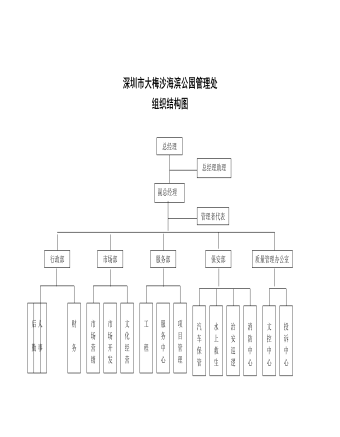
公司管理制度(适用于旅游发展公司)
第一条 总经理岗位职责(一) 确立公司战略目标和服务宗旨,制定相应的经营方针、质量方针、质量目标,并制定具体实施措施和服务质量标准;(二) 审定签署公司重大合同,审批公司财务预算、决算,控制各项开支和成本消耗提高经济效益和社会效益;(三) 聘、任免公司部门经理以上职员,决定公司机构设置、员工编制及重要人事变动;(四) 审定各级管理人员的职权范围,协调管理关系,调动各级管理人员的工作积极性和主动性;(五) 组织新项目的开发和重大文化经营活动的策划审批;(六) 须经总经批准的其他重大事项。第二条 副总经理(助总)岗位职责(一) 协助总经理执行公司各项决议,完成总经理作出的经营计划及总经理分配的各项具体工作;(二) 督导具体业务部门的服务质量达到规定的质量目标和标准,掌握日常经营的具体情况;(三) 检查公司管理制度、岗位责任制和服务程序的落实、执行情况;(四) 就总经理提出经营战略、活动方案、项目开发等提出合理化建议,对旅游市场进行研究并发表见解,供总经理参考。第三条 行政部经理岗位职责(一) 负责本部门日常工作的组织实施,完成公司下达的责任目标和质量目标;(二) 主持制订公司各项管理规章制度;(三) 负责具体组织质量体系的实施、维持和改进工作;(四) 协调平衡各部门的关系;(五) 负责公司人事、行政、后勤管理;(六) 负责组织员工岗位应知应会培训工作;(七) 负责公司对外行政、接待工作;(八) 负责制订公司发展计划;(九) 总经理交办的其他事务;第四条 行政主管岗位职责(一) 协助行政部经理处理日常行政事务;(二) 负责公司的计划生育工作;(三) 负责内、外公关协调工作;(四) 负责劳动纪律的检查和员工违纪的调查处理,协调保安部做好员工违纪行为的调查、处理工作;(五) 负责做好公司食堂、宿舍的管理工作;(六) 做好来信来访工作;协助服务部解决处理游客投诉事件;(八) 行政部经理交办的其他工作。第五条 人事主管岗位职责(一) 据上级有关文件精神和公司领导的意图起草和修改公司人事管理的有关规定;(二) 根据人事规定负责办理干部、员工、临时工的调入、招聘、招收、试用、签订合同、调出、辞退的各项手续;(三) 负责申报暂住员工暂住户口的申办暂住证工作;(四) 按上级要求做好各种人事统计报表,及时准确掌握干部、职工的变化情况;(五) 负责公司管理人员的绩效考核,并定期向行政部经理及和总经理报告。;(六) 负责人事档案资料的充实归档和转入转出的传递工作;(七) 行政部经理交办的其他工作。第六条 财务主管岗位职责(一) 制报表及财务报表说明,对各项业务波动较大的项目要加以分析,提出建议;(二) 按照全国统一会计科目,进行会计的帐务处理;(三) 按照财务制度,每十五天为一期编制会计记帐凭证;(四) 根据各部门考勤表、考核表,计发当月工资、奖金;(五) 按照国家税收规定,负责管理接收工作;(六) 严格按照财务制度的要求,认真做好记帐凭证的稽核,组织会统表的编审工作,保证财务决算的正确、及时、真实,为领导提供可靠的经营管理资料;(七) 及时掌握流动资金使用和周转的情况,定期向行政部经理汇报工作;(八) 行政部经理交办的其他工作。第七条 行政秘书岗位职责(一) 负责收集、综合各种信息为总经理决策提供咨询和依据,当好参谋;(二) 负责公司重要文件的起草及媒体宣传;(三) 修正各部室报送打印的对外文件或材料;(四) 作好会议记录,整理并草拟重要会议纪要或决定;(五) 收发总经理的各种信件、来函,对各种重要和急办的函件进行分类,并提醒总经理加以注意;(六) 协助管理者代表建立、建全、完善、维护、审核、改进服务质量体系;(七) 负责企业文化的策划工作;(八) 做好总经理和其他领导交办的事务。
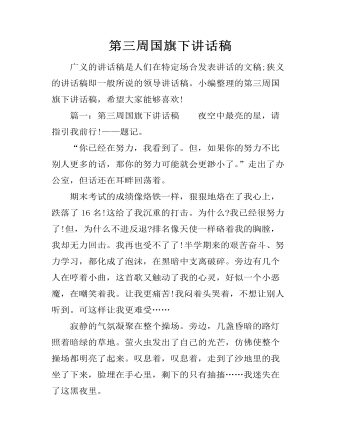
第三周国旗下讲话稿
广义的讲话稿是人们在特定场合发表讲话的文稿;狭义的讲话稿即一般所说的领导讲话稿。小编整理的第三周国旗下讲话稿,希望大家能够喜欢!篇一:第三周国旗下讲话稿 夜空中最亮的星,请指引我前行!——题记。“你已经在努力,我看到了。但,如果你的努力不比别人更多的话,那你的努力可能就会更渺小了。”走出了办公室,但话还在耳畔回荡着。期末考试的成绩像烙铁一样,狠狠地烙在了我心上,跌落了16名!这给了我沉重的打击。为什么?我已经很努力了!但,为什么不进反退?排名像天使一样硌着我的胸膛,我却无力回击。我再也受不了了!半学期来的艰苦奋斗、努力学习,都化成了泡沫,在黑暗中支离破碎。旁边有几个人在哼着小曲,这首歌又触动了我的心灵,好似一个小恶魔,在嘲笑着我。让我更痛苦!我闷着头哭着,不想让别人听到。可这样让我更难受……寂静的气氛凝聚在整个操场。旁边,几盏昏暗的路灯照着暗绿的草地。萤火虫发出了自己的光芒,仿佛使整个操场都明亮了起来。叹息着,叹息着,走到了沙地里的我坐了下来,脸埋在手心里,剩下的只有抽搐……我迷失在了这黑夜里。
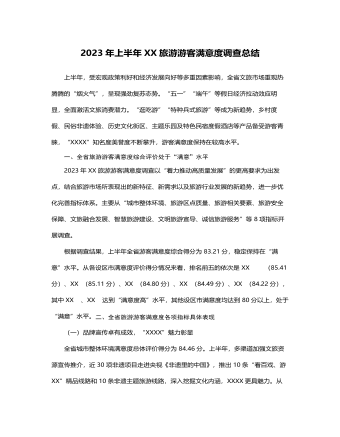
2024年上半年XX旅游游客满意度调查总结
(六)智慧旅游场景拓展,数字科技助力复苏全省智慧旅游建设满意度总体评价得分为82.45分。“XXXX”数字旅游卡销售量持续上升,“南博奇妙夜”“中国大运河博物馆”等富有创意、极具新意的沉浸式数字体验空间频频“出圈”,为游客营造多层次、多维度、高品质的文化旅游体验。从各设区市得分情况来看,XX 84.35分、XX 84.26分、XX 84.21分,排名前三;从细项指标来看,电子支付85.45分、电子票务系统84.71分和通信网络84.65分,排名前三。(七)宣传引导持续推进,文明旅游氛围浓郁全省文明旅游宣导满意度总体评价得分为83.34分。运用丰富多样的载体和方式开展文明旅游宣传,让游客时时处处感受到文明旅游的浓厚氛围,文明旅游引导员、文明旅游志愿者都给游客留下了深刻印象。从各设区市得分情况来看,XXX 84.63分、XX 84.55分、XX 84.52分,排名靠前;从细项指标来看,文明旅游建设84.01分和文明旅游宣传83.84分评价较高。
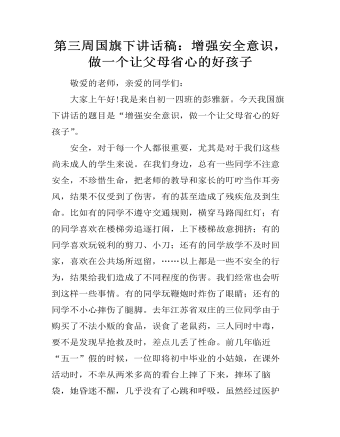
第三周国旗下讲话稿:增强安全意识,做一个让父母省心的好孩子
敬爱的老师,亲爱的同学们:大家上午好!我是来自初一四班的彭雅新。今天我国旗下讲话的题目是“增强安全意识,做一个让父母省心的好孩子”。安全,对于每一个人都很重要,尤其是对于我们这些尚未成人的学生来说。在我们身边,总有一些同学不注意安全,不珍惜生命,把老师的教导和家长的叮咛当作耳旁风,结果不仅受到了伤害,有的甚至造成了残疾危及到生命。比如有的同学不遵守交通规则,横穿马路闯红灯;有的同学喜欢在楼梯旁追逐打闹,上下楼梯故意拥挤;有的同学喜欢玩锐利的剪刀、小刀;还有的同学放学不及时回家,喜欢在公共场所逗留,……以上都是一些不安全的行为,结果给我们造成了不同程度的伤害。我们经常也会听到这样一些事情。有的同学玩鞭炮时炸伤了眼睛;还有的同学不小心摔伤了腿脚。去年江苏省双庄的三位同学由于购买了不法小贩的食品,误食了老鼠药,三人同时中毒,要不是发现早抢救及时,差点儿丢了性命。前几年临近“五一”假的时候,一位即将初中毕业的小姑娘,在课外活动时,不幸从两米多高的看台上摔了下来,摔坏了脑袋,她昏迷不醒,几乎没有了心跳和呼吸,虽然经过医护人员的全力抢救,至今也没有脱离危险。
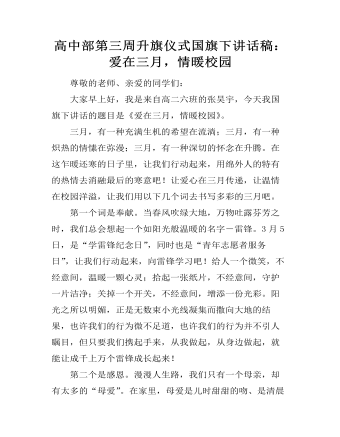
高中部第三周升旗仪式国旗下讲话稿:爱在三月,情暖校园
尊敬的老师、亲爱的同学们:大家早上好,我是来自高二六班的张昊宇,今天我国旗下讲话的题目是《爱在三月,情暖校园》。三月,有一种充满生机的希望在流淌;三月,有一种炽热的情愫在弥漫;三月,有一种深切的怀念在升腾。在这乍暖还寒的日子里,让我们行动起来,用绵外人的特有的热情去消融最后的寒意吧!让爱心在三月传递,让温情在校园洋溢,让我们用以下几个词去书写多彩的三月吧。第一个词是奉献。当春风吹绿大地,万物吐露芬芳之时,我们总会想起一个如阳光般温暖的名字―雷锋。3月5日,是“学雷锋纪念日”,同时也是“青年志愿者服务日”,让我们行动起来,向雷锋学习吧!给人一个微笑,不经意间,温暖一颗心灵;拾起一张纸片,不经意间,守护一片洁净;关掉一个开关,不经意间,增添一份光彩。阳光之所以明媚,正是无数束小光线凝集而撒向大地的结果,也许我们的行为微不足道,也许我们的行为并不引人瞩目,但只要我们携起手来,从我做起,从身边做起,就能让成千上万个雷锋成长起来!第二个是感恩。漫漫人生路,我们只有一个母亲,却有太多的“母爱”。在家里,母爱是儿时甜甜的吻、是清晨路上的几句叮咛、是眼角两旁的一条皱纹、是秋风吹散的一缕白发……在学校,母爱是润物无声教会我们打开知识大门的钥匙,是不辞劳苦帮助我们扬起理想风帆的桅杆,是无微不至拨开我们心灵阴霾的春风……
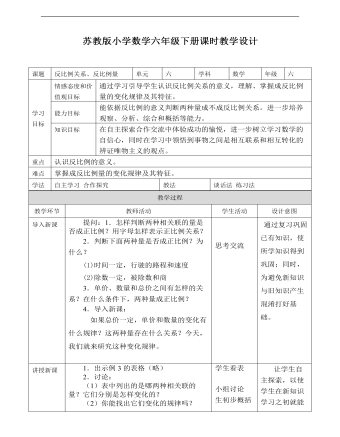
小学数学苏教版六年级下册《第六单元第三课反比例关系、反比例量》教学设计说课稿
提问:1.怎样判断两种相关联的量是否成正比例?用字母怎样表示正比例关系? 2.判断下面两种量是否成正比例?为什么? (1)时间一定,行驶的路程和速度 (2)除数一定,被除数和商 3.单价、数量和总价之间有怎样的关系?在什么条件下,两种量成正比例? 4.导入新课: 如果总价一定,单价和数量的变化有什么规律?这两种量存在什么关系?今天,我们就来研究这种变化规律。


